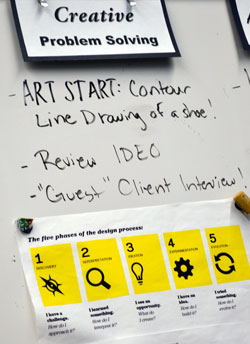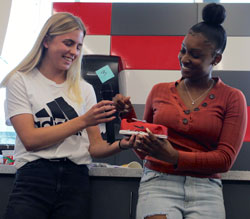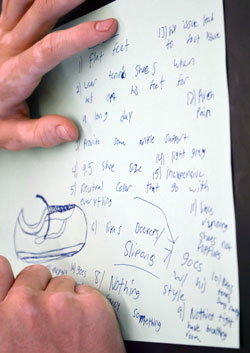Those who know — or think they know — high school Athletic Director Patrick Marsman might be surprised to learn how particular he is about his shoes.
“I have bad feet, to be honest. I had been doing a lot of running years ago, and they really started to give me trouble. I’ve worn orthotics because one hip is actually higher than the other. They often hurt after a long day, especially Fridays when I’ve been at school and there’s a game at night.

“I don’t like tight shoes, don’t like tight stuff in general. Leather? That would be a no. They have to be breathable. I walk a lot in my typical day: the field, all around the complex, making sure everything’s perfect. And I tend to get nervous on game days, so I pace a lot.”
The insight didn’t come as confessions. Marsman was answering pointed questions about his 9-and-a-halfs from students in Tricia Erickson’s creative problem-solving class.
Like Ali Norcutt, who wanted to know: flat feet or high arch? Flat.
Or Jaryn Cleveland, who asked if Marsman has “foot arthritis.” Nope.
And Jacob Koning, who wondered if Marsman wears his regular shoes in the snow. Guilty as charged.
The task: build the perfect shoe for Marsman.
“If you could design me one pair of shoes?” Marsman told students. “Something that was ultra-comfortable on the bottoms. Like, squishy comfortable. And grippy, not slippy. It gets smoking hot in the gym and that floor can get slick. And if you can rig up a foot massager in there? I am buying those shoes.”
Bonus points if they’re grey and red. And if they cost less than $100, “because I’m very particular,” Marsman said, “but I don’t like to spend a lot of money.”

In the Business World
Erickson’s students are learning how to use design thinking in their creative process, through a semester-long class called Creative Problem-Solving. Open to any grade, the class was introduced about five years ago after learning about design thinking and its relevance to the business world.
“We also wanted to create a course that focused on the importance of creativity and design without requiring the fine art skills that sometimes intimidate students who haven’t taken an art class in a while,” Erickson said. “They still learn some of the traditional art skills and techniques, but (the class) is infused with the simple concept of practice makes you better and failure is okay, as long as you learn from it.”
“I’m a creative person,” said senior James Smith III. “I thought this (class) would help me evolve into putting my ideas to the test, to engage in the real world with hands-on activities, and to communicate with a team working together and with clients.”
Erickson said the first year the class was offered the focus was on “integrating common core subjects to help reinforce concepts that students commonly struggle with. Then we started to reach out to local businesses as a capstone for the class, to have students work with real ‘clients’ on real-world ‘problems.’ The class has worked with corporations like Meijer, Steelcase and software company Mavin Global, as well as local universities, businesses and community members.
“It is sometimes hard to explain just how much they do,” Erickson said. “In addition to learning ways to systematically think creatively, they learn a lot about speaking publicly — and do so often –, pitching ideas quickly, working within design teams, communicating professionally, staying productive, learning from mistakes, good design aesthetics, the latest technology trends, and maybe most important of all: empathy and understanding for others.

A Shoe Just for You
A week after interviewing Marsman, student groups presented their third and final prototypes to the client himself. Concepts included the Magic Marsmans, the Wildcat Flats and the Air Marsman 88s — to commemorate the year he started working at the school.
Marsman did choose a style he liked best — it’s a real-world exercise, after all — but being the chosen winner of any of the challenges is not the point of the class.
“It’s not the design of the shoes they’re being graded on, it’s the process,” Erickson pointed out. “It’s how they engaged every step of the way, from the notes they took to whether they demonstrated that they understood the goal, and how, even after their final presentation, they are able to reflect on how they would refine their approach and their product even more.”
And the class is just as highly regarded by the teacher as it is by students.
“This is, hands down, one of my favorite classes to teach, because the students learn so much,” Erickson said. “This class pushes students out of comfort zones, and challenges me as a teacher every time I teach it.”














